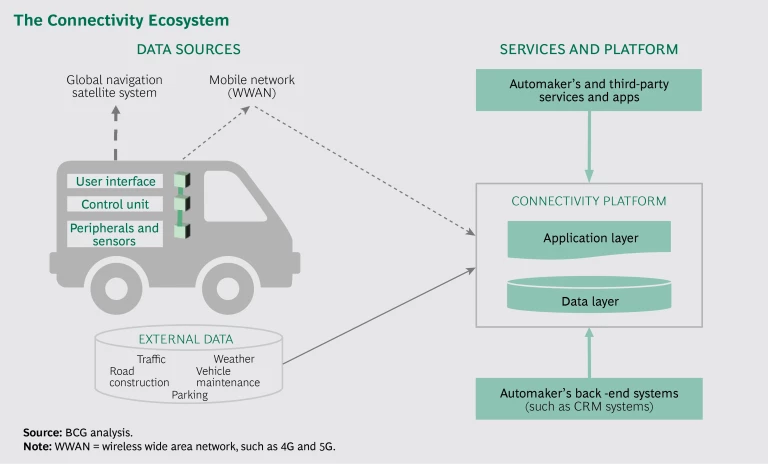Connected vehicles have become the next big thing for the automotive industry. And little wonder: the market for in-vehicle connectivity—the hardware and services bringing all kinds of new functionality to drivers and fleet owners—is expected to reach €120 billion by 2020. Automakers know that the opportunity is huge and they want in. But so far, they are struggling to turn that potential into significant revenue and profits. The next big thing has yet to become the next big business.
The promise of a connectivity business can be realized, but it will require automakers to embrace significant changes in their connectivity strategy, organization, and mindset. For one, they’ll have to think and work more like technology companies: adopt faster development cycles; approach monetization in new ways, such as by offering subscription-based services; and build platforms that woo partners and customers alike. As the smartphone market has demonstrated, companies that create vibrant ecosystems full of compelling products take the lead.
Automakers also need the right starting place, a market segment where they can hone their monetization model quickly and build revenue, experience, and momentum. Once the right segment is identified, a company can focus on where the money is most likely to flow—and then build on that success by expanding to other market segments.
Light Commercial Vehicles
So where is the sweet spot for monetization? In our view, the light commercial vehicle (LCV) market is a front-runner. It earns that distinction for three main reasons.
Commercial customers recognize a clear business case for connectivity. Successful monetization turns on a willingness to pay, and commercial customers tend to score high here—much higher than individuals. That’s because connectivity brings them not only convenience but also measurable business value. Fleet owners, for example, can decrease fuel costs through intelligent navigation; minimize downtime through predictive maintenance; and better integrate their vehicles into their value chain by linking them to order management systems and other IT platforms. Such benefits translate into real improvements in operational efficiency.
The market for connected commercial vehicles is growing significantly. The number of active fleet management systems—a key measure of connectivity demand—is increasing sharply. In Europe, 2 million systems covering LCVs and heavy commercial vehicles (CVs) were in use in 2010, with more than 10.6 million expected by 2020.
LCVs bring scale. While the previous factors apply to all commercial vehicles, the LCV market has a special advantage: in 2016, some 15.1 million LCVs were sold worldwide, compared with 2.6 million CVs. This large volume of vehicles provides manufacturers a good opportunity to get their connectivity technology into the field. By installing the necessary hardware in new vehicles, companies can create a large base of potential users for their connectivity services and do so more quickly than they could by relying on retrofits.
We recognize, of course, that not every automotive company offers LCVs. But the factors that make this market ideal, such as a willingness to pay and the number of vehicles sold, can be useful criteria for identifying an alternative segment for monetization.
Willingness to pay and the number of vehicles sold, can be useful criteria for identifying a promising market segment for monetization.
The Essential Elements of a Connectivity Business
Connectivity is not a traditional automotive product, and a connectivity business should look quite different from a vehicle manufacturer’s usual ventures. No matter how promising a front-runner market segment may be, manufacturers need a strong foundation for supporting and building a connectivity business. The following four elements are essential to that foundation.
Targeted Solutions. The most compelling—and sought after—solutions are those that meet top-priority needs. Often such needs are industry-specific. So, in addition to a default set of offerings with broad appeal, such as a maintenance-check reminder app, automakers should create more narrowly focused solutions that will appeal to specific types of customers. A parcel service, for example, might especially value a connectivity app that optimizes fleet usage—say, by locating and routing the closest vehicle, in real time, whenever a new pickup request comes in. A rental car company, on the other hand, might value what’s known as a geofencing app, which helps enforce boundaries, such as country borders, that its vehicles are not permitted to cross.
An Open Marketplace. Any given vehicle manufacturer is unlikely to have the resources or know-how to create a diverse portfolio of applications. So how can it fill in the gaps? One answer is to turn to third-party developers. Right now, most connectivity platforms are proprietary, or closed. But by opening the door to outside developers, manufacturers can vastly expand their service portfolios and their platforms’ appeal. The smartphone business offers a clear example of how a marketplace rich in compelling offerings can pay off: think Apple and Google. It also shows how the lack of such a marketplace can doom even the most promising technology. Indeed, despite significant investment and smart hardware design, the platforms of some mobile players faltered because they lacked a wide range of apps.
Multibrand Platforms. Many commercial customers operate mixed fleets. They may have vehicles from different manufacturers or carry older vehicles as well as new models. They may even buy used vehicles. These customers are likely to have a lot of different connectivity hardware in their fleet, whether installed in new vehicles or retrofitted by the vehicle manufacturers or by a customer via third-party providers. An app that works with 10 vehicles out of 200 will have little appeal for these customers. Connectivity platforms, therefore, should be independent of hardware. Multibrand platforms aren’t a perfect solution. An automaker will always know its own systems best and may be unable to use the data generated by another brand’s hardware in the same way it uses data from its own. But multibrand platforms make connectivity solutions more broadly appealing—an advantage powerful enough to easily outweigh their limitations.
A Strong Monetization Strategy. Vehicle manufacturers will find that there are several different routes leading to potential revenue in connectivity. Automakers need to understand these different options and leverage the ones that are most promising. A vibrant app marketplace, for instance, can help drive hardware sales for a platform—a dynamic made strikingly clear by Apple’s App Store, which is a big driver of iPhone sales. Automakers could also sell the data collected by their connectivity solutions to other companies, which might gain useful insights from it. But perhaps above all, monetization like the kind that Apple and Google have achieved requires scale. Manufacturers must work to get as many users as possible onto their platform to reach a critical mass. This will create momentum, attracting even more users—and developers—and creating still more momentum. Such a cycle continually increases the potential of the platform.
Connecting the Dots
Understanding the key elements to making money in connectivity is an important first step for vehicle manufacturers. Next come the nuts and bolts of applying these principles in practice. How, for instance, do application developers home in on industry-specific solutions? The automakers that lead in connectivity will be the ones that develop, sell, and support the right solutions in the right way. To do this, they’ll need to embrace some new approaches.
Identify solutions that provide value. Creating customer-specific applications might seem an arduous task, requiring an automaker or third-party developer to fully understand the needs of every type of customer it wants to attract—and the capabilities that will add value. But the task can be done in a structured way. For the commercial segment, fleet size provides a good first indicator of customer needs. Small fleets (fewer than 10 vehicles) typically require vehicle-specific, off-the-shelf solutions, such as an app that can manage multiple drivers and keys for each vehicle. A large-fleet customer, on the other hand, will often want to integrate its vehicles with existing IT systems, requiring a data interface and customized solutions.
From this general breakdown, a solution provider can focus on more specific needs by looking at the customer’s industry. Requirements will vary—sometimes widely—from one sector to another. A construction company, for instance, is likely to value localization and navigation services so that drivers can pinpoint the exact spot they need to go to in a construction zone. A transport company, meanwhile, may have greater need for predictive maintenance, intelligent routing, and real-time job sequencing.
Design integrated customer touch points. As a technology offering, connectivity presents a challenge when it comes to sales and support. Some customers may still prefer the vehicle dealership to be their primary contact and point of sale. Others may want to learn about solutions, and even select them, online. It’s crucial to integrate digital and physical channels. If a customer walks into a showroom after choosing a configuration online, the dealer should know what was selected so the process doesn’t have to begin again from scratch.
Manufacturers should also note that connectivity is a new and different product for dealers, too. Selling, installing, and activating systems is time consuming, yet dealers may not see any direct revenue from it. How can automakers ensure that dealers make the effort necessary for the platform to succeed? Incentives can help, and they don’t have to be complicated. A manufacturer can set an annual or quarterly sales target for connectivity service subscriptions. When dealers meet this goal they receive bonus compensation.
As in the smartphone arena, app stores can serve double duty: as a marketplace for services but also as a showcase—via product descriptions, case studies, screenshots, and other resources—for how solutions can benefit customers. Automakers can enhance these platforms further by using certain tools, such as on-demand chat with connectivity specialists who can provide more individualized support. By providing quick, accurate answers to specific, sometimes complex, questions, manufacturers can drive customer satisfaction and sales.
Create a separate connectivity organization. Automakers stand to benefit from structuring their connectivity business as a separate entity for a couple of reasons. First, there is the uniqueness of the product. Standalone development, marketing, and other functions can be both appropriate and advantageous given how different connectivity is from automakers’ traditional businesses. Moreover, as a separate entity, a connectivity business can more easily implement and leverage a digital way of working. For instance, it can foster collaboration in cross-functional teams; continually update products instead of following the traditional five-to-seven-year vehicle development cycle; and even deliver new software over the air, as Tesla does. It’s a faster, more flexible approach to developing products, allowing companies to better compete in the digital era.
Exploit institutional knowledge. There are many ways to organize a separate connectivity business; vehicle manufacturers could go as far as creating a distinct legal entity with its own branding. But they can also gain competitive advantages, especially against startups playing on the same turf, by maintaining links to their existing automotive business. Automakers already have a wealth of knowledge about vehicles and a trove of data about their customers. They have existing retail channels, as well. Such resources can be invaluable when developing and selling connectivity solutions.
Leverage data, but with care and transparency. In-car sensors and systems capture an array of valuable data that can be used in various ways. Internal usage—leveraging data to improve products and processes and to create additional services—should be a manufacturer’s top priority. Selling the data is much more complex but may also offer opportunities. However it is put to use, customer data must be managed responsibly. Customers care about how their data is used, who will access it, and how it will be secured—and they’re often skeptical about whether their concerns are being heard. A 2016 BCG survey of 8,000 consumers in the US and five European countries revealed that only 20% of respondents trust companies to do the right thing with their data. For connectivity to work, both as a platform and a business, establishing trust must be the rule, not the exception. Data usage agreements must spell out clearly how data will be handled and how customers can restrict undesired usage.
Embrace and enable an ecosystem of partners. Open marketplaces will go a long way toward encouraging third-party developers to build apps for a vehicle manufacturer’s connectivity platform. But partnerships are key in a more behind-the-scenes aspect, as well. Connectivity will invariably call for skills and capabilities outside a manufacturer’s expertise. (See the exhibit.) Automakers will need to be software developers. They’ll have to bill customers in new ways, such as through monthly subscriptions or service-based payments. They’ll also require the right infrastructure—perhaps cloud-based platforms—to support their new services. And they’ll have to manage the flow of data from vehicle to platform to application. Many of these capabilities are unlikely to be found in-house and may be difficult or expensive to develop. But by establishing a network of partners, automakers can get quick access to the resources they need. Time to market, risk, and cost can all be reduced while quality and revenue increase.
A network of partners will help automakers cut cost, time to market, and risk, while increasing quality and revenue.
The Road Forward
For the automotive industry, connectivity can provide a path to new revenue and profits. Implementing it well will be a challenging, complex task, requiring a deep understanding of customer needs and a willingness to work in new ways with new partners. The approaches described above can help vehicle manufacturers develop and implement a solid foundation for connectivity. But they’re not a magic potion. As companies develop their platforms, they will contend with evolving technologies and market conditions. They’ll also need to address details that may not be readily apparent at first but that could have significant implications. One such detail, for instance, is how data roaming will be handled. This is a particularly important question in Europe, where drivers often cross country borders.
There will be strategic considerations as well. Once manufacturers have established their connectivity platform, they may want to think about whether it should be leveraged to drive vehicle sales, and if so, how. For example, even if an automaker offers multibrand solutions, it might want to favor its own brand in some way—say, by making some features available only for the vehicles it produces. While such a strategy could boost vehicle sales, it could also make the connectivity product less appealing to owners of other brands. Automakers will need to weigh the tradeoffs carefully, striking a balance that maximizes overall growth.
Connectivity is unfamiliar ground for vehicle manufacturers, but it’s full of potential. Companies that approach this business wisely will maximize the appeal of their products, the speed at which they get them to market, and the revenue they derive from them. They’ll find that this engine will take them as far as their imaginations allow.







